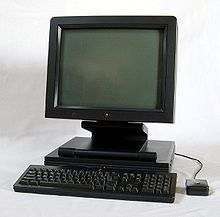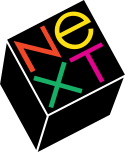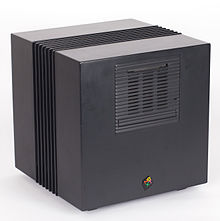NeXT
| NeXT, Inc.
|
|
|---|---|
| legal form | Corporation |
| founding | 1985 |
| resolution | 1996 |
| Reason for dissolution | Takeover by Apple |
| Seat | Redwood City , California, USA |
| management | Steve Jobs |
| Branch | Electrical industry, software |
The company NeXT, Inc. [ nɛkst ] (later also NeXT Computer, Inc. or NeXT Software, Inc. ) was an American computer and software manufacturer. It was founded in 1985 by Steve Jobs after he had to leave Apple as a result of internal disputes.
Based in Redwood City , California , the company designed and manufactured a number of workstations for use in academia and business. The first NeXT computer was presented in 1988, the smaller NeXTstation in 1990. Although the two devices found their niche in the research area, they were not able to establish themselves on the market, which was also attributed to the high prices of around 6,000 US dollars . In total, it is estimated that only 50,000 devices were sold.
The NeXTStep operating system with its innovative graphical user interface is considered to be groundbreaking in many aspects. The structure, equipment and the entire technical design of the visually outstanding computers also had a great influence on today's personal computers , operating systems and desktop environments .
In late 1996, NeXT was bought by Apple for $ 429 million and 1.5 million Apple shares. Part of the deal was that Jobs returned to Apple after an eleven year absence. The NeXT software was further developed by Apple and thus partially forms the basis of today's operating systems macOS , iOS , watchOS and tvOS .
Company history
After Steve Jobs left Apple with five colleagues Rich Page, George Crow, Bud Tribble, Dan'l Lewin and Susan Barnes in 1985, they founded NeXT Computer, Inc. with Randy Heffner and Gary H. Moore in 1986. Steve Jobs controlled 7 million US dollars from its own assets to the establishment. In 1987 Ross Perot acquired a 16 percent stake in NeXT for $ 20 million. In October 1988, Steve Jobs introduced the first NeXT computer in San Francisco. From September 1989 this was also delivered as a NeXTcube . Also in 1989 Canon acquired a 16.6 percent stake in NeXT for $ 100 million.

In 1990 the NeXTstation was presented, a flat "pizza box" that was placed under the monitor.
At the end of 1990, a sales organization consisting of NeXT Deutschland GmbH (Munich), three NeXT centers (d'ART Hamburg, AMG Dortmund and DCS Waldbronn near Karlsruhe) and numerous NeXT partners, including the computer department of Karstadt - Oberpollinger in Munich, was established in Germany.
In 1993 NeXT said goodbye to the hardware business and developed the platform-independent software NeXTStep for Intel , NeXTstep for Motorola (NeXT hardware) and for special Unix workstations ( PA-RISC ) from HP and SPARC , and - at least in the laboratory - also for IBM PowerPC .
As part of the reorientation, the company name was changed to NeXT Software, Inc. in 1995 . Together with Sun Microsystems , OpenStep had been specified, a specification for an object-oriented program interface (API) and NeXT implemented this in version 4.0 of its NeXTStep, which from then on was marketed under the name OPENSTEP (in capital letters) to indicate portability. NeXT's operating system ran as “OPENSTEP for Mach” on its own Motorola-based hardware and on Intel computers, and as “OPENSTEP Enterprise” as an add-on on Windows NT . At the same time, WebObjects was an object-oriented development and runtime environment for dynamic websites.
Finally, on December 20, 1996, the company was bought by Apple Computer for $ 429 million. Steve Jobs returned to Apple and served as CEO from 1997 until he stepped down in August 2011 . The NeXTStep / OPENSTEP operating system, the Mach microkernel and the OpenStep specification, together with FreeBSD, formed the basis for today's Apple operating system macOS. The German managing director Gerhard Tauschl continued the WebObjects business at Apple as Sales Manager Enterprise Business Europe, based on WebObjects. a. the iTunes Store.
Open source projects such as the AfterStep window manager and GNU Window Maker make the look and feel of the NeXT user interface available for other operating systems. An OpenStep-compatible API for Unix systems is being developed with the GNUstep project.
On the workstations from NeXT also makes NetBSD to use as an alternative modern operating system.
Importance in data processing

Under him, both the first web browser and the first web server were developed.
NeXT company has made significant contributions to advances in information technology. In NeXTStep and the NeXT computers, concepts that later became standard were made available to a broader public for the first time. Examples:
- The first object-oriented graphic development environment with which the creation of user interfaces for programs was carried out with a graphic, mouse-operated editor. The use of Display PostScript , i.e. the page description language for print output on the monitor, was of particular importance , so that a complete WYSIWYG concept was implemented.
- Company-wide networking of work groups with a graphic interface. The network configuration database Netinfo and the GUI-based programs for its use allow simple configuration of computer networks without in-depth knowledge of the underlying Unix operating system.
- First uniform installation and deinstallation system for programs.
- The publicly available " Mach " kernel from Carnegie Mellon University was used and refined as the basis. A system basis was created that lives on in macOS , iOS and in the activities of the Unix / Linux community.
- In addition to the main CPU, the NeXT computers had a DSP to improve the computing power when processing certain data. This concept arose through parallel evolution in today's GPUs for calculating general processes ( GPGPU ).
- The NeXT computers were the first computer systems that were not only delivered as hardware with an operating system, but also with an extensive software package, which partly explained the higher price.
design
The NeXT workstations were designed by the company frog design of the product designer Hartmut Esslinger . Because of the extraordinary design , some NeXTcubes are exhibited in museums, for example in the New Collection of the Pinakothek der Moderne in Munich and in the Museum of Modern Art in San Francisco.
Others
- Tim Berners-Lee developed the basics of the World Wide Web on a NeXTcube from October 1990 . On December 24, 1990, he and his colleague Robert Cailliau , who also owned such a computer, communicated for the first time over the Internet with the info.cern.ch server . Both the first browser and editor WorldWideWeb and the first web server thus ran on NeXTStep.
- The NeXT logo was designed by Paul Rand . NeXT made Rand's commitment cost $ 100,000.
See also
swell
- Walter Isaacson: Steve Jobs . btb, Munich 2012, ISBN 978-3-442-74491-6 .
- Off to new shores with NeXT
- The NeXT story
Web links
- The Best of NeXT Collection
- NeXT computer brochure
- old-computers.com - NeXTcube
- Byte Magazine, November 1988: The NeXT Computer Facsimile , full text
- Photos of black hardware
Individual evidence
- ↑ a b Stephan Ehrmann: 10 years of Mac OS X: An Apple success story. In: Heise online . March 24, 2011 (based on today's purchasing power , the price Apple paid for NeXT is approximately $ 697,694,100). Retrieved November 3, 2019 .; Quote: "Jobs' company NeXT was acquired for $ 429 million."
- ↑ Apple Computer, Inc. Agrees to Acquire NeXT Software Inc. Apple Computer, December 20, 1996, archived from the original on February 8, 2002 ; accessed on June 13, 2008 .
- ↑ Owen W. Linzmayer: Apple Confidential: The Real Story of Apple Computer, Inc . 1999 (English).
- ^ BusinessNews Publishing: Summary: The Second Coming Of Steve Jobs - Alan Deutschman . The Story Behind Apple's CEO and Co-Founder. Primento, 2014, ISBN 978-2-511-01682-4 (English, limited preview in Google Book Search [accessed January 23, 2016]).
- ^ Virtual exhibition catalog, Museum of Modern Art San Francisco
- ↑ Tim Berners-Lee, Mark Fischetti: The Web Report. The creator of the World Wide Web on the boundless potential of the Internet , Econ Verlag, Munich 1999. ISBN 3-430-11468-3 (p. 55)

